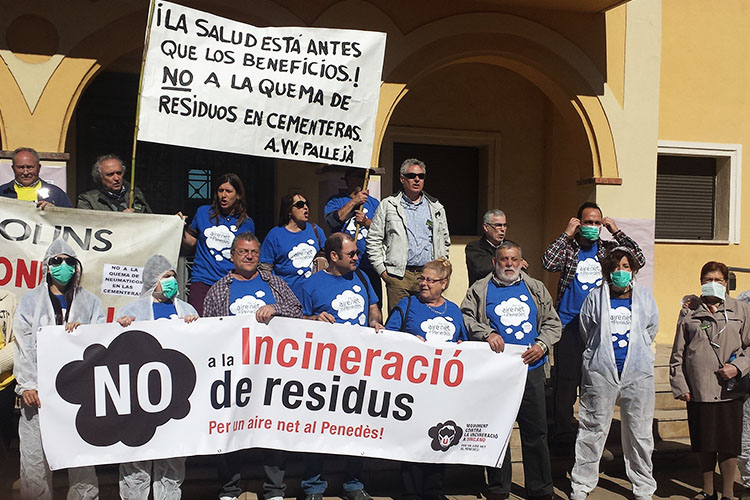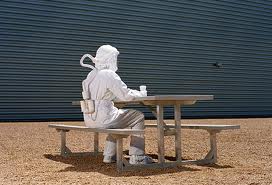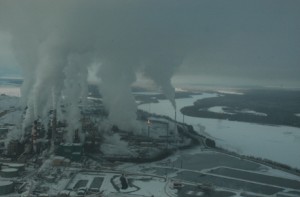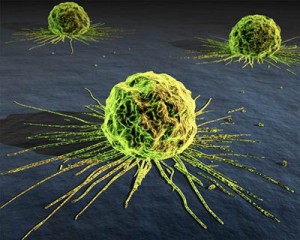Cancer
Monthly TEDX Teleconference Tutorial on the Hazards of Fracking
 Founded by the late great Theo Colburn, who along with her co-authors of "Our Stolen Future" way back in 1996 just about invented the field of "endocrine-disrupting chemicals," the Endocrine Disruption Exchange (TEDX) is holding a monthly teleconference series begining in April focusing on chemicals associated with fracking.
Founded by the late great Theo Colburn, who along with her co-authors of "Our Stolen Future" way back in 1996 just about invented the field of "endocrine-disrupting chemicals," the Endocrine Disruption Exchange (TEDX) is holding a monthly teleconference series begining in April focusing on chemicals associated with fracking.
First up on Thursday, April 7th at 1 pm is Dr. Chris Kassotis, who's been looking at the connection between fracking chemicals and surface and ground water contamination near fracking sites. According to the TEDX release, Kassotis will speak about…
"…his recently published research demonstrating increased endocrine disrupting activity in surface and ground water near fracking wastewater spill sites, as well as nuclear receptor antagonism for 23 commonly used fracking chemicals. His studies have shown prenatal exposure to a mixture of those chemicals at likely environmentally relevant concentrations resulted in adverse health effects in both male and female C57 mice, including decreased sperm counts, modulated hormone levels, increased body weights, and more. Dr. Kassotis will also discuss his recent work showing increased receptor antagonism downstream from a wastewater injection disposal site.
Dr. Kassotis is a Postdoctoral Research Associate in the Nicholas School of the Environment at Duke University. He completed his PhD at the University of Missouri working with Susan Nagel to assess unconventional oil and gas operations as a novel source of endocrine disrupting chemicals in water, and the potential for adverse human and animal health outcomes from exposure.
This April get together is one of three briefings being given from now until June. According to a preview of the next two calls:
Thursday May 5, 2016, 1:00 pm Central – Dr. Shaina Stacy will discuss "Perinatal outcomes and unconventional natural gas development in Southwest Pennsylvania"
Thursday June 2, 2016, 1:00 pm Central – Dr. Nicole Deziel will discuss "A systematic evaluation of chemicals in hydraulic-fracturing fluids and wastewater for reproductive and developmental toxicity"
You have to go online and register as a participant if you want to listen in or ask quesitons via a live chat line.
Spanish Study: Link Between Cement Kilns and Cancer
 Although it was first published last July, news of a new Spanish epidemiological study of residents living in proximity to cement plants has just now reached us.
Although it was first published last July, news of a new Spanish epidemiological study of residents living in proximity to cement plants has just now reached us.
Done by the the same researchers responsible for a 2012 study that found statistically significant increases in all cancers around waste incineration and auto scrap metal operation, this more recent report focuses just on cement, lime and plaster plants.
According to the researchers, a statistically signifiant increase in all cancer mortality was detected in the vicinity of these installations as a whole, but principally, in the vicinity of cement installations. Specifically, tumors of the colon–rectum in both sexes and of the pleura peritoneum, gallbladder, bladder and stomach in men were noticably higher. In a summary of the results, the authors state they believe residents have "an excess risk of dying from cancer, especially in colon–rectum, in towns near these industries."
Because they take such a long time and so much effort, there's a dearth of epidemiological studies focused entirely on cancer risks among those living in proximity to cement plants, although a 2004 Italian study found a significantly greater risk of lung cancer among people living near a cement factory (whereas the results of another Italian study confirmed significant excesses for cancers like the nervous system, leukemia, mesothelioma and peritoneum in a region with the presence of various industries including cement factories.
In explaining the higher incidence of gut cancers among both men and women, the study hypothesizes about the possible ways local residents are exposed to carcinogens:
In our study, one aspect to be borne in mind is that colorectal
cancer is the only tumor with statistically significant excess risks
in men and women, which might be indicative of a pathway of
environmental exposure. In this case, two possible routes of exposure
to the pollution released by these installations are considered:
direct exposure to pollutants released to air; and indirect exposure,
both to pollutants and liquid effluents which are released to water
and can then pass into the soil and aquifers, and pollutants which
are released to air and then settle on plants. In such cases, the toxins
may pass into the trophic chain, affecting the population.Some authors have already shown associations between colorectal cancer and proximity to industrial pollution sources as metal industries (Garcia-Perez et al., 2010), mining (Fernandez-Navarro et al.,2012), food and beverage sector (Lopez-Abente et al., 2012) andchemical plants (Wilkinson et al., 1997). As regards cement plants,
a Brazilian study found a significant elevation on colorectal cancer
mortality in an industrialized area with cement industries came
into operation in the 1960s, among other facilities (Medrado-
Faria et al., 2001), and a Korean occupational study suggested a
potential association between exposure in the cement industry
and an increased risk of rectal cancer (Koh et al., 2013).
One thing a lot of these overseas studies and the Midlothian area have in common is a concentration of heavy industry. There's usually more than one facility and the region is considered an industrial corridor. That's certainly true of Midlothian, where besides hosting three large cement plants, the town is also home to a huge secondary steel mill, a power plant, and now an LNG plant. These industries combine to present a multitude of possible synergestic combinations of toxins to anyone living adjacent to, or downwind of them. "Toxic soup" is a term often used to describe the result.
This is also why the law lags behind the science in setting standards for cause and effect. When it's the cascade of chemicals from various facilities assaulting you, you're rarely going to be able to link a particular disease or illness with a specific plant. And yet the harm is happening all the same. This is why institutionalizing the "Precautionary Principle" into public policy is so important. It's much easier to prevent a chemical exposure than to track all of its ill effects after it's already doing damage.
Better Living Avoiding This Chemistry: An Industrial Toxic Primer
 Even though this EcoNews article is about air poisons that result from fossil fuel production, it applies to just about any combustion source, including cement plants, manufacturing plants, vehicles, and so on. It's a pretty good top ten list, although you wonder why Dioxins and Furans got left off, since they're toxic by the gram instead of pound. Also missing is Particulate Matter as a stand alone threat, although it gets a shout out as a by-product. Nevertheless, these are the among the most dangerous pollutants that have caused and are still causing a lot of problems in North Texas and elsewhere:
Even though this EcoNews article is about air poisons that result from fossil fuel production, it applies to just about any combustion source, including cement plants, manufacturing plants, vehicles, and so on. It's a pretty good top ten list, although you wonder why Dioxins and Furans got left off, since they're toxic by the gram instead of pound. Also missing is Particulate Matter as a stand alone threat, although it gets a shout out as a by-product. Nevertheless, these are the among the most dangerous pollutants that have caused and are still causing a lot of problems in North Texas and elsewhere:
1. Benzene
Benzene is a well-established carcinogen with specific links to leukemia as well as breast and urinary tract cancers. Exposure to benzene reduces red and white blood cell production in bone marrow; decreases auto-immune cell function (T-cell and B-cells); and has been linked to sperm-head abnormalities and generalized chromosome aberrations.
Benzene is one of the largest-volume petrochemical solvents used in the fossil fuel industry. It is a major component in all major fossil fuel production: oil, coal and gas. People are exposed to it from inhaling automobile exhaust and gasoline fumes, industrial burning such as oil and coal combustion, and exposure to fracking fluids.
There's a recent Emory University study concluding that risk for leukemia fell with every mile between a person's home and facilities that release benzene.
2. & 3. Sulfur Dioxide (SO2) and Nitrogen Oxides (NOx)
Sulfur dioxide (SO2) and nitrogen oxides (NOx) are two primary examples of particle-forming air pollutants (particulate matter). Particulate matter is known to contribute to serious health problems, including lung cancer and other cardiopulmonary mortality. SO2 and NOx are both highly toxic to human health, and contribute directly to thousands of hospitalizations, heart attacks and deaths annually.
SO2 is particularly dangerous for children. Studies correlate SO2 emissions from petroleum refineries—even in lower exposure levels over time —to higher rates of childhood asthma in children who live or attend school in proximity to those refineries. Similarly, small particles of NOx can penetrate deeply into sensitive lung tissue and damage it, causing premature death in extreme cases. Inhalation of such particles is associated with emphysema and bronchitis.
4. Petroleum Coke (Pet Coke)
Pet coke is a by-product of oil processing that's also used as a fuel. It's a heavy dust which resembles coal. It's burned in power plants and cement plants. It contains dozens of dangerous chemicals and heavy metals, including chromium, vanadium, sulfur and selenium. It's a huge contributor to particulate mater and NOx and SOx formation
5. Formaldehyde
Formaldehyde is a carcinogen with known links to leukemia and rare nasopharyngeall cancers, according to the International Agency for Research on Cancer. Formaldehyde is highly toxic regardless of method of intake. It is a potent allergen and genotoxin. Studies have linked spontaneous abortions, congenital malformations, low birth weights, infertility and endometriosis to formaldehyde exposure. Epidemiological studies link exposure to formaldehyde to DNA alteration. It is also contributes to ground-level ozone.
Independent studies, have detected dangerous levels of formaldehyde in both wastewater and ambient air emissions from fracking operations. One researcher, with the Houston Advanced Research Center, said reading from one test site in North Texas, “astoundingly high,” and, “I’ve never heard of ambient (formaldehyde) concentrations that high… except in Brazil.”
6. Polycyclic Aromatic Hydrocarbons (PAHs)
In actuality, this is not a single listing—polycyclic aromatic hydrocarbons (PAH) is an entire class of toxic chemicals, linked together by their unique chemical structure and reactive properties.
Many PAHs are known human carcinogens and genetic mutagens. In addition, there are particular prenatal health risks: prenatal exposure to PAHs is linked to childhood asthma, low birth weight, adverse birth outcomes including heart malformations and DNA damage.
Additionally, recent studies link exposure to childhood behavior disorders; researchers from Columbia University, in a 2012 Columbia University study, found a strong link between prenatal PAH exposure and early childhood depression. Infants found to have elevated PAH levels in their umbilical cord blood were 46% more likely to eventually score highly on the anxiety/depression scale than those with low PAH levels in cord blood. The study was published in the journal Environmental Health Perspectives.
7. Mercury
Mercury is a dangerous neurotoxin emitted from coal-fired power plants and any other combustion source using coal for fuel – like the Midlothian cement plants. It damages the brain and the nervous system either through inhalation, ingestion or contact with the skin. It is particularly dangerous to pregnant women and children. It is known to disrupt the development of the in-vitro brain. In low doses, mercury may affect a child’s development, delaying walking and talking, shortening attention span, and causing learning disabilities. High dose prenatal and infant exposures to mercury can cause mental retardation, cerebral palsy, deafness and blindness. In adults, mercury poisoning can adversely affect fertility and blood pressure regulation and can cause memory loss, tremors, vision loss and numbness of the fingers and toes.
One out of every six women of childbearing age in the U.S. have blood mercury levels that could be harmful to a fetus, according to EPA reports. The EPA estimates that 300,000 children are born each year at risk for significant development disorders due to mercury exposure.
8. Silica (Silicon Dust/Sand)
Crystalline silica (“frac sand”) is a known human carcinogen; breathing silica dust can lead to silicosis, a form of lung disease with no cure. This is a hazard in the cement industry and threat to those living downwind of cement plants, and now it appears to be one for natural gas roughnecks and adjacent homeowners as well.
Silica is commonly used, in huge amounts, during fracking operations. Each stage of the process requires hundreds of thousands of pounds of silica quartz–containing sand. Millions of pounds may be used for a single well.
The presence of silica in fracking operations, simply put, is a major safety risk with a high likelihood of dangerous exposure. Case in point: researchers from the National Institutes of Occupational Safety and Health (NIOSH) recently collected air samples at 11 fracking sites in five different “fracking states” (CO, ND, PA, TX and AR) to evaluate worker exposure to silica. Every single site had measures higher than the NIOSH threshold for safe exposure—so high, in fact, that about one-third of the samples collected were even above the safe threshold for wearing a safety respirator mask. This was reported in May 2013 in the Journal of Occupational and Environmental Hygiene.
9. Radon
Radon is a colorless, odorless, tasteless radioactive gas which causes lung cancer. It is the second largest cause of lung cancer in the U.S. after cigarette smoking. About 20,000 people per year die from lung cancer attributed to radon exposure according to the National Cancer Institute. Further, there is no known threshold below which radon exposures carries no risk.
Radon exposure can come from a variety of natural sources. However, fracking (natural gas) represents a significant new and increased source of radon exposure to millions of citizens. Radon is released into local groundwater and air during fracking operations. It also travels through pipelines to the point of use—be it a power plant or a home kitchen.
The science behind radon release and exposure is complex but explained well here by Christopher Busby, the Scientific Secretary of the European Committee on Radiation Risk, who warns that radon dangers from fracking “have not been addressed properly (or at all) by the environmental impact statements published by the operators, or by the Environmental Protection Agency in the USA.”
10. Hydrofluoric Acid (HF) / Hydrogen Fluoride
Hydrofluoric acid (HF) is “one of the most dangerous acids known.” HF can immediately damage lungs, leading to chronic lung disease; contact on skin penetrates to deep tissue, including bone, where it alters cellular structure. HF can be fatal if inhaled, swallowed, or absorbed through skin.
The senior laboratory safety coordinator at the University of Tennessee said, “Hydrofluoric Acid is an acid like no other. It is so potent that contact with it may not even be noticed until long after serious damage has been done.”
Hydrofluoric Acid is a common ingredient used in oil and gas extraction.
Numerous studies, including recent ones conducted by both The Center for Public Integrity (CPI) and the United Steelworkers Union (USU) cite the oil industry’s abysmal safety record as a high risk factor for a major HF accident; over the past decade, more than 7,600 accidental chemical releases from refineries have been reported by the industry. In the past three years alone, a total of 131 “minor” accidents involved HF.
Study Reveals Cancer Hot Spots Downwind of Canadian Oil and Gas Processing Centers
 On the heels of the World Health Organization declaring air pollution a carcinogen, a study published this week from the University of California-Irvine and University of Michigan found higher levels of specific carcinogens in communities downwind of Canadian "oil, gas and tar sands processing zones", and higher rates of Luekemia and non-Hodgkin’s lymphoma among men living in those downwind communities.
On the heels of the World Health Organization declaring air pollution a carcinogen, a study published this week from the University of California-Irvine and University of Michigan found higher levels of specific carcinogens in communities downwind of Canadian "oil, gas and tar sands processing zones", and higher rates of Luekemia and non-Hodgkin’s lymphoma among men living in those downwind communities.
Despite their rural location, the recorded levels of the carcinogens, including 1,3-butadiene and benzene, were higher than in some of the world's most polluted cities. Examining area health records that went back a decade showed the number of men with leukemia and non-Hodgkin’s lymphoma was greater in the communities closest to the pollution plumes.
The authors strongly recommended that the industrial emissions be decreased to protect both workers and nearby residents.
“Our study was designed to test what kinds of concentrations could be encountered on the ground during a random visit downwind of various facilities. We’re seeing elevated levels of carcinogens and other gases in the same area where we’re seeing excess cancers known to be caused by these chemicals,” said UC Irvine chemist Isobel Simpson, lead author of the paper in Atmospheric Environment. “Our main point is that it would be good to proactively lower these emissions of known carcinogens. You can study it and study it, but at some point you just have to say, ‘Let’s reduce it.’
Co-author Stuart Batterman, a University of Michigan professor of environmental health sciences, agreed: “These levels, found over a broad area, are clearly associated with industrial emissions. They also are evidence of major regulatory gaps in monitoring and controlling such emissions and in public health surveillance.”
Dr. Batterman is familiar to Downwinders old timers as being the first scientist to take on the state's laughable "Health Risk Assessment" of TXI's burning of hazardous waste at it Midlothian cement plant. In what became known simply as the "Batterman Report," his mid-1990's critique of the official document was devastating in its scope and depth. It became a template on how to deconstruct any TCEQ attempt to gloss over the dangers of living downwind of a large polluter.
In this new study, Dr. Batterman and his colleagues monitored emissions in the rural Fort Saskatchewan area downwind of major refineries, chemical manufacturers and tar sands processors owned by BP, Dow, Shell and other companies in the so-called “Industrial Heartland” of Alberta. Taking random one-minute samples in 2008, 2010 and 2012, the results were very similar over time – amounts of some of the most dangerous Volatile Organic Compounds were 6,000 times higher than normal. Higher than in Mexico City during the 1990s or in the still polluted Houston-Galveston area.
Simpson said the findings were important for other residential areas downwind of refineries and chemical manufacturers, including parts of Los Angeles.
“For any community downwind of heavy industrial activity, I would say it’s certainly prudent to conduct surveys of both air quality – especially carcinogens – and human health."
World Health Organization: Air Pollution Causes Lung Cancer
 As of Thursday, the air you breathe CAN kill you, at least according to the World Health Organization, which officially classified air pollution as a cause of lung cancer. The move came after the group released a report earlier this year estimating that over 220,000 people died from lung cancer worldwide from exposure to bad air. Most of those deaths are occurring in countries in Asia.
As of Thursday, the air you breathe CAN kill you, at least according to the World Health Organization, which officially classified air pollution as a cause of lung cancer. The move came after the group released a report earlier this year estimating that over 220,000 people died from lung cancer worldwide from exposure to bad air. Most of those deaths are occurring in countries in Asia.
Mostly these deaths are due to Particulate Matter pollution, the ubiquitous tiny particles of soot that are produced when things burn, like gas in cars, coal or gas or waste in power plants and cement kilns, and diesel engines and flares in the the gas fields.
Researchers have been producing one study after another for years linking a variety of illness and diseases to various ingredients of dirty air and specifically, Particulate Matter. Parkinson's Disease and other nerve and brain-related ailments, heart attacks and strokes, and of course respiratory problems have all been blamed on PM, but this is the first time it's been classified as a carcinogen. Most scientists in the field believe that there's really no level of exposure to the pollution that's completely "safe."
PM levels in DFW are generally low, but they've been rising over the last couple of years, and those measured levels are based on all of two monitors for all of the Metromess, so they could mask hot spots downwind of large sources (think Midlothian, compressors, and busy freeways). The EPA has proposed a new federal standard that's much lower than the current one, but it has yet to be implemented.
Past Colorado Medial Society Prez: Fracking is an “Experiment in Motion” on Public Health
 Dr. Michael Pramenko seems like a reasonable guy. He's not a Greenpeace treesitter, or running for elected office, or part of any unruly mob.
Dr. Michael Pramenko seems like a reasonable guy. He's not a Greenpeace treesitter, or running for elected office, or part of any unruly mob.
In fact, he's so reasonable that he's the former president of the Colorado Medical Society.
And Dr. Pramenko calls the current hydraulic fracturing boom in the state’s oil and gas industry an “experiment in motion. One that could lead to higher rates of cancer and other illnesses over the next 10 to 15 years."
But he's not concerned with the massive acute exposures that can happen during accidents or blow-outs. No, he's concerned with the harm done by the routine, boring everyday kind of low-level chronic exposure that the Texas Tech researchers in the post below are documenting.
“Are there people out there being exposed to low quantities [of carcinogens] that we won’t ever know about? Sure,” he said. “Are there going to be some cancers down the road that come about across the United States? I think that's true.
You'll be relieved to know that state regulators have everything under control. Colorado Department of Public Health and Environment (CDPHE) spokesman Mark Salley said the department closely monitors the industry to protect public health: “The [CDPHE] has regulations in place, including required permitting, set-back requirements, use of ‘best practice’ methods by industry to minimize the impacts.”
Yes, that should do it.
There are 50,771 active oil and gas wells in Colorado – 20,260 of them in Weld County on the northern Front Range. More than 90 percent of the state’s wells are fracked at least once and often multiple times.
Trying to regulate fracking hazards is like trying to hit a moving target. Every month there's a new study out that shows a new threat or one that has been under-emphasized. Like so many other on-going experiments we're a part of, this one will claim thousands before we understand what was really happening.
Another Study Reveals Why Our System of “Safe Levels” is a Tragic Mirage
 Gas well, cement plant, lead smelter, plastics plant, refinery, compressor, incinerator. Anyone who's ever lived next door to an industrial polluter knows there's the way the facility appears to be operating on paper and how it's actually operating in the real world.
Gas well, cement plant, lead smelter, plastics plant, refinery, compressor, incinerator. Anyone who's ever lived next door to an industrial polluter knows there's the way the facility appears to be operating on paper and how it's actually operating in the real world.
The way it's operating on paper is completely portable. You can take this version of the facility anywhere. The numbers and printouts and charts can show up to congressional hearings. They can be included in PowerPoint presentations, along with glossy pics of the place itself. They can be summarized. They have no smell. They have no texture. They don't make a sound. On paper, expressed in language and figures, the facility may seem to be operating properly under every permitted limit it has to abide by.
On the ground however, it may be a completely different story. It may mean strange petrochemical or plastic smells wafting through your house in the middle of the night. It could mean a series of loud explosions or pops that nobody has ever been able to explain to you. It could mean rashes on your skin, or headaches, or nausea, or asthma attacks. It could mean living in fear of chemical assault. All the time.
This version of operations is not portable. One can write about it or talk about it, but that will not put other people there. And indeed, descriptions of these circumstances can sound so nightmarish that listeners assume you're exaggerating. You're not. Not even video or film can immerse you in it. No amount of reporting about it can make you feel in it. The map is not the place. The only way to know this side of operations is to live it. Day in, day out.
The difference between what the paper version of polluting says, and what the people living it know, is a front line of social justice in the 21st Century.
It also happens to be a major frontline for science, as demonstrated by a recent landmark study from, of all places, Texas Tech about how the sum of pollution is greater than its sometimes desperate parts We're late in covering this, but thanks to the Denton Record Chronicle's for bringing it to our attention back in June. Because this study underscores once again in a big way why our entire system of regulating chemical exposures is so completely contrary to what we know about how those exposures are affecting us.
Tech scientists took two chemicals that are known to cause cancer in large amounts, arsenic and estrogen, and exposed human prostate cells to very low amounts of each. The amounts they exposed the prostate cells to were so low, they fell below the EPA regulatory "safe" level that limits releases of the chemicals from polluters. Individually, the exposures of the cells to arsenic and estrogen were so low as to believed to be harmless. But they weren't.
Instead, the Tech researcher's peer-reviewed, journal-published study found the combination of the low doses of the two chemicals combined was almost twice as likely to create cancer in the prostate cells as the single chemical exposures individually. That is, the toxic interaction or "cumulative effect" of the two chemicals was more than the sum of their parts. There was a "synergestic" reaction inside the cells that the current regulatory system doesn't recognize as even a possibility.
“The majority of cancers are caused by environmental influences,” Singh said. “Only about 5 to 10 percent of cancers are due to genetic predisposition. Science has looked at these chemicals, such as arsenic, and tested them in a lab to find the amounts that may cause cancer. But that’s just a single chemical in a single test. In the real world, we are getting exposed to many chemicals at once.”
Singh became interested in looking at arsenic because water well problems in his native India had recently highlighted mass poisonings from contamination of the chemical. He wondered how this exposure would interact with other carcinogens within the same population.
He focused on estrogen as the second chemical because of the chemical’s ubiquity. Many plastics, such as food can liners, release bisphenol A (BPA), and other chemicals that mimic estrogen in the body.
Unlike more potent chemicals that do major damage to the DNA in a cell, such as benzene, arsenic and estrogen aren’t major mutagens Singh said. Instead, their presence tends to stop certain genes from expressing. The process is called DNA hypermethylation.
…the two chemicals stopped the MLH1 gene, which is responsible for sending the signal to start the self-destruct sequence when a cell is damaged. Because the self-destruct couldn’t activate, the cells became cancerous after exposure.
“With the lower dose not killing the cell, it’s causing damages that go under the cell’s radar. We found when you have two compounds together, lower doses could be more serious problem.”
This is what's called a non-linear impact. You can actually get harmed more by long term low-level exposures than by intense bursts of short term exposure – exactly the opposite of the way the system regulates chemical exposures now.
Currently that system assumes it can protect the public health from exposures to over 80,000 chemicals on the marketplace by regulating the average intake of these chemicals one at a time. It says: "we know that lead and benzene are bad for you if you OD on them, but by only exposing you to a little bit every day, we can keep you from getting damaged by its health effects." The dose is the poison. A little bit cant hurt you, but a lot can kill you.
Unfortunately, this view, which is the foundation for all modern regulatory schemes for chemical pollution, is based on a worldview of human physiology that's now dangerously out of date. For the past 50 years at least, study after study has shown that there are a lot of less-than-drop-dead health effects that couldn't be diagnosed without modern technology. The more we learn about how how bodies work the more we learn new ways about how chemicals can really screw them up. The Tech study is just the latest, albeit dramatic example.
Moreover, of those 80,00 chemicals only about 200 can be said to have been studied even remotely "thoroughly" and fewer that that have been examined for their interactions with any of the other 79,999. So the system itself is a big fat theory in progress, with very little real science supporting it. We're all its Guinea Pigs. It's an hypothesis.
But its a hypothesis with billions invested in it. So to prove it wrong is to threaten a lot of people with a lot of money.
Which is why the chemical industrial-government complex is trying very hard to hold back the tide of this kind of science and what it means. Meanwhile the gap between the paper version of how things are operating at a facility and the real world impact of those operations continue to grow. At some point the contradictions will be too much to ignore or withstand. But we're a long way from that point yet. Which is why we need your help to keep fighting on behalf of those folks living the truth on the ground and prevent more victims of this obsolete and harmful regulatory system.
New Studies Link Air Pollution to Cancer, Heart Failure and…Appendicitis?
 According to CBS News
According to CBS News
"A new study published July 10 in The Lancet showed that even breathing low levels of air pollution for a prolonged period of time could raise risk for the often-deadly lung disease. Another study released on the same date showed that short-term exposure to most major air pollutants could increase the risks of hospitalization and death from heart failure."
Lung cancer risks went up 18% with each increase of 5 migrograms of PM 2.5. Researchers noted that they did not find a level of pollution for where there was no risk, and the results indicated "the more the worse, the less the better" when it came to pollution.
"At this stage, we might have to add air pollution, even at current concentrations, to the list of causes of lung cancer and recognize that air pollution has large effects on public health," Takashi Yorifuji from the Okayama University Graduate School of Environmental and Life Science and Saori Kashima from Hiroshima University in Japan…."
A second study shows the risk of dying or going to the hospital because of heart failure increased by 3.52 percent for every 1 part per million increase of carbon monoxide levels; 2.36 percent for every increase of 10 parts per billion of sulfur dioxide; 1.7 percent for ever 10 parts per billion increase in nitrogen dioxide; and about 2 percent for every 10 micrograms per cubic meter increase of particulate matter. Surprisingly, increases in ozone were not linked to heart failure. Unsurprisingly, you're breahting in all of these kinds of air pollution if you live in DFW.
All of that is kind of old news – put stuff in air, see stuff harm your lungs and heart. But here's a new "adverse health effect" being linked to air pollution – appendicitis. While not as lethal as lung cancers and heart attacks, anyone who's had their appendix rupture can tell you it's not a pleasant experience.
And while ozone may not have been linked to heart problems in that previous study, the New York Times reports a Canadian one links it to a slight increase in your chances of having appendicitis.
High ozone levels were associated with an increased number of hospitalizations for appendicitis and were even more strongly associated with cases of burst appendix. For each 16 parts per billion increase in ozone concentration the scientists found an 11 to 22 percent increase in ruptured appendix cases. The study was published in Environmental Health Perspectives. The associations persisted after controlling for age, sex, season of the year and the presence of other air pollutants, like nitrogen dioxide and particulate matter. The reason for the association is unclear, but studies in mice have shown that air pollution can alter the animals’ abdominal bacteria.
Who knew?
Congressional Report: Environmental Causes of Breast Cancer Must be Researched
 "Most cases of breast cancer “occur in people with no family history,” suggesting that “environmental factors — broadly defined — must play a major role in the etiology of the disease.” That's the conclusion of something called the Interagency Breast Cancer and Environmental Research Coordinating Committee, which came out with a report last week.
"Most cases of breast cancer “occur in people with no family history,” suggesting that “environmental factors — broadly defined — must play a major role in the etiology of the disease.” That's the conclusion of something called the Interagency Breast Cancer and Environmental Research Coordinating Committee, which came out with a report last week.
In 2012, Breast cancer was diagnosed in 227,000 women, killed 40,000, and cost more than $17 billion to treat in the United States.
Yet only a fraction of federal research funding has gone toward examining links between breast cancer and ubiquitous chemicals such as the plastic hardening agent bisphenol A; the herbicide atrazine; and dioxin, a byproduct of plastics manufacturing and burning, says the report, prepared for Health and Human Services Secretary Kathleen Sebelius.
“National survey data show that many of these chemicals are present in the blood or urine of children and adults in the United States, and some EDCs are present in 100 percent of the people sampled. Exposure to such compounds early in life can be especially dangerous, the report says.
All told, some 84,000 chemicals are registered for use in the United States. But complete toxicological screening data are available for only 7 percent of these substances, says the report, which calls for “enhanced testing of chemicals, especially classes of chemicals combined together as a mixture, for effects on the mammary gland and breast …”
“Prevention needs to be as important as other investments that are made in screening, treatment and access to care,” Jeanne Rizzo, co-chair of the committee and president of the San Francisco-based Breast Cancer Fund said in an interview. “There really is a problem, and until we address it we’re going to continue to have a quarter of a million new cases every year.”
The report’s release comes three months after a Center for Public Integrity article detailing a study of female plastic automotive parts workers in Windsor, Ontario. That study found that women employed in the chemical-intensive industry were nearly five times as likely to develop breast cancer, prior to menopause, as women in a control group.
“That was essentially an uncontrolled human study,” Rizzo said of the Windsor workers. “We can’t do that. We need to learn from animal studies.”
In the United States, an estimated 150,000 female workers in the plastics and synthetic rubber industries are likely exposed to many of the same chemicals as the women in Windsor, including polyvinyl chloride, or PVC, plastic; acrylonitrile; formaldehyde and styrene.
At least 216 chemicals, including endocrine-disrupting substances like bisphenol A, have been associated with mammary gland tumors in animals. Endocrine-disrupting chemicals, or EDCs, are used to make plastics and pesticides and found in products such as furniture, metal food cans and cosmetics.
But environmental exposures have gotten relatively little attention from researchers.
The National Institutes of Health spent almost $2.4 billion on 2,910 breast cancer research projects from fiscal year 2008 through fiscal year 2010. But only about 27 percent of these projects had to do with prevention, and just 10 percent could be considered “environmental health research.”
Of the $2.8 billion appropriated by Congress from 1992 through 2012 for the Department of Defense Breast Cancer Research Program, 75 percent went toward “basic biology and treatment research, with only 3 percent for prevention and cancer control projects."
The committee recommends that researchers prioritize “chemicals that are produced in high volumes for which there is biologically plausible evidence of their role in the development of breast cancer.”
It also suggests that regulators improve oversight of “cosmetics and personal care products as well as household cleaning and food containment products,” and step up environmental monitoring, especially of “underserved and under-researched groups as well as ‘fenceline’ communities that are in close proximity to industry or waste sites.”
Red Alert for Dec 20th: Dallas Wants to Drill Like It’s 2009
 This is a heads-up to all Dallas residents: Dallas City Hall – the building, the people, everything – has climbed into a time machine and traveled all the way back to 2010.
This is a heads-up to all Dallas residents: Dallas City Hall – the building, the people, everything – has climbed into a time machine and traveled all the way back to 2010.
This has allowed the City council and staff to ignore citizen demands for a more protective gas drilling ordinance, the defeat of a council member who advocated drilling, the creation and conclusion of a task force for helping write a new ordinance, and a bunch of public hearings over the last two years – all so that Dallas City Hall can now just go ahead and do what the gas operators originally asked it to do at the beginning.
The first Special Use Permit request from a gas well operator to allow drilling in Dallas since 2010 will be on the agenda at the December 20th Dallas Plan Commission meeting at City Hall. It concerns a new request to drill by XTO (Exxon-Mobil) at the old Navel Air Station in southwest Dallas, near the Grand Prairie line, that was submitted on November 16th.
Time it's taken the City of Dallas to write a new drilling ordinance in Dallas: 24 months and counting
Time it took XTO to get its new drilling request heard despite not having that new ordinance yet: 20 days
You can read about the sudden jump into municipal action here behind the DMN paywall.
"XTO’s latest requests are apparently on a fast track, headed to the City Plan Commission….
A new, tougher Dallas drilling ordinance is in the works but has not been approved or even published for review, so the existing ordinance would govern the XTO applications, based on the city’s legal view that one set of rules should apply throughout the process."
Every Dallas City Council member appoints a representative to the City Plan Commission. Dallas residents should call their own City Council member (info here), or their Plan Commission appointee (download a list and contact info here) and tell them to reject this XTO request and any others that try to get processed before a new drilling ordinance is in place.
Here's the media release that Dallas Residents at Risk put out this morning about the sudden turn around:
Dallas Officials Consider Throwing Away Years of Work on New Gas Drilling Ordinance and Simply Let Fracking Begin
Have Mayor Rawlings and the Dallas City Council made a decision to move ahead with existing, pending and even new gas drilling applications without taking any action on the new “fracking” ordinance that has been in the works since 2010?
Two weeks ago, Exxon-owned gas company XTO filed a new gas drilling application—because their previous bid to drill at Hensley Field was denied by the Dallas City Plan Commission two years ago. Then the City Council appointed a special Gas Drilling Task Force, whose members met every week for eight months to consider proposals for a new ordinance. They finished their work in February of this year and issued their official recommendations, yet the City Council has not even begun drafting a new ordinance. The only rumored exception: City officials may consider simply changing the existing ordinance to allow fracking in floodplains, which would be necessary for gas company Trinity East to move ahead with its plans to drill in floodplain areas along the Trinity River. Neighborhood groups and environmental advocates say that’s unacceptable.
"This is the largest retreat of leadership that I can ever remember on such an important public health and environmental issue,” said Jim Schermbeck, Downwinders at Risk. “After three years of citizen complaints, a task force created, convened and concluded, expert and public testimony, and all Dallas residents get is a pair of shrugged shoulders from Mayor Rawlings and the Council? It's a bad joke."
There have been several major scientific studies surrounding the risks of fracking since Dallas officials began debating the new ordinance. Community leaders worry that new evidence pointing to health and safety risks for residents living near drilling sites will simply be ignored.
“So what if there's a 66% higher cancer risk within a half mile of a gas well; so what if already bad Dallas smog is made worse; so what if we still have no idea what chemicals will be used for fracking in Dallas,” said Claudia Meyer of the Mountain Creek Neighborhood Alliance. “It's as if the Mayor and Council are closing their eyes, plugging their ears, and desperately hoping to make all these new facts go away by just pretending they never happened.”
The new drilling applications leave Dallas officials exactly where they started, with the City Plan Commission being asked to shoulder the responsibility of deciding on whether to allow fracking to go forward. Advocates say the Commission should decline this offer and let the City Council do what it said it was going to do: Draft and pass a new gas drilling ordinance first.
“If we were only going to end up where we started, what was the point of a task force, or public hearings or anything that's happened since permitting stopped because the City wanted a new drilling ordinance,” said Zac Trahan with Texas Campaign for the Environment. “This is complete and utter dereliction of duty and public trust by the elected officials of this city on one of the most important public health and environmental questions to face Dallas in decades."
